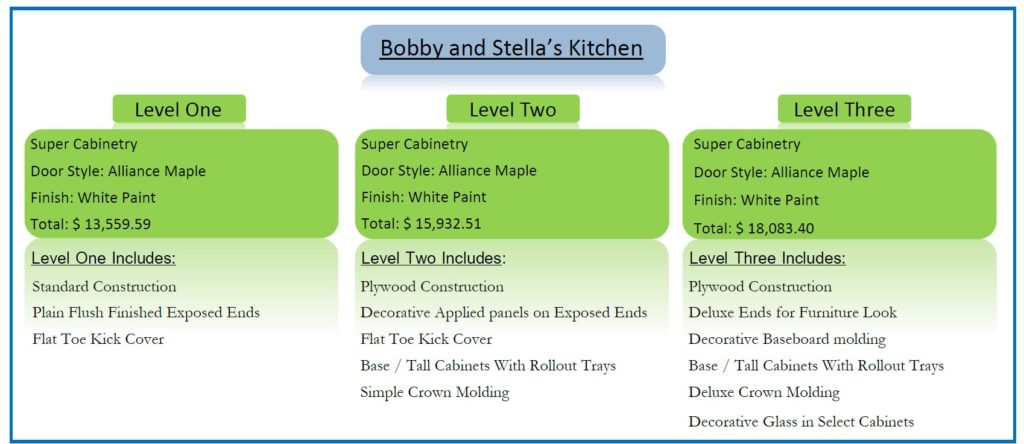If you have been shopping for a laptop computer lately, you probably have discovered that there are a multitude of choices, depending on the configuration, size, memory, etc. that you might be looking for.
Some manufacturer web sites also allow you to select the models that you are interested in and do a side-by-side comparison so you can easily view the features that you will get with each package.
Next time you are presenting a medium to large kitchen design, why not use the same methods to present to your client?
All clients like to have choices, that is why manufacturers of products provide so many choices. By doing so, if they have already convinced you that you should be buying their brand, they can present a range of choices with different price points so that they can sell to the widest range of consumers possible.
Think about this the next time you prepare a presentation of a design to a client. (you do prepare for that presentation, right?)
If I am your client and I have just reviewed the final presentation of my project and heard the price, my knee-jerk reaction is to search for options and choices to bring that cost down. I think that is the natural experience for anyone consider a large purchase.
If your client does not plainly know the options and choices that make alternative pricing possible, they are going to shop elsewhere to seek out these options.
Keep your client in house to explore their options!
Instead of presenting only one option to them, present a sheet that gives them option packages. Many home builders do the same thing when you are considering building a home. There are packaged upgrades available that include certain features and products with each level.

I prefer presenting packages simply as “Level One” “Level Two” or “Level Three”. Some folks who teach this idea use “Good”, “Better”, and “Best”, but I feel that what is “Best” is really subject to the client’s perspective.
I like to call this Menu-based or Menu-driven selling. This defines exactly what it is; giving your client a list of choices to pick from. It also can make the experience more enjoyable to the client because they could enjoy picking and choosing which features are important to them. I know it sounds kind of cheesy, but it is very much the “would you like fries with that?” approach.
Would you Like Fries with That?
With each package, state the features that come with each, and then a total cost with each package. You might start with a basic one that includes cabinets with standard construction only and basic installation. Then, you might move into packages that include tearing out the old space, cabinets with plywood construction, etc. Then all the way up to the whole package including crown moldings, rollout trays, moving walls, etc.
Using this method of price presentation, your client will know immediately upfront that they have options. They may even pick and choose from these packages to create their own “package” of options.
The most important part of using this presentation method is that you can take your client from “As much as I liked this experience, I can’t buy this here because it is too expensive so I will shop elsewhere.” to “I liked this experience and will buy this here, but I need to decide how much stuff to include.”
Chances are that you have already spent some time with the client to carefully help them to select the perfect brand for them. This will help to keep them within that same brand of cabinetry, flooring, etc. without them feeling the need to explore other brand options that in the end, may not be the best choice for them.
Try this and you will find it will earn you more sales and keep people inside your business, rather than compelling your clients to shop against you.
I would love to hear your experiences using this.
Thanks for reading, subscribing and sharing. As always, your comments and thoughts are welcome!


Love this
Thanks so much, Linda! Please share this with others who may benefit from this.